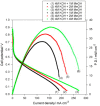Anion Exchange Membranes with 1D, 2D and 3D Fillers: A Review
- PMID: 34833189
- PMCID: PMC8622584
- DOI: 10.3390/polym13223887
Anion Exchange Membranes with 1D, 2D and 3D Fillers: A Review
Abstract
Hydroxide exchange membrane fuel cells (AEMFC) are clean energy conversion devices that are an attractive alternative to the more common proton exchange membrane fuel cells (PEMFCs), because they present, among others, the advantage of not using noble metals like platinum as catalysts for the oxygen reduction reaction. The interest in this technology has increased exponentially over the recent years. Unfortunately, the low durability of anion exchange membranes (AEM) in basic conditions limits their use on a large scale. We present in this review composite AEM with one-dimensional, two-dimensional and three-dimensional fillers, an approach commonly used to enhance the fuel cell performance and stability. The most important filler types, which are discussed in this review, are carbon and titanate nanotubes, graphene and graphene oxide, layered double hydroxides, silica and zirconia nanoparticles. The functionalization of the fillers is the most important key to successful property improvement. The recent progress of mechanical properties, ionic conductivity and FC performances of composite AEM is critically reviewed.
Keywords: AEMFCs; LDH; MOF; carbon dots; carbon nanotubes; graphene oxide; silica; zirconia.
Conflict of interest statement
The authors declare no conflict of interest.
Figures















References
-
- Varcoe J.R., Slade R.C.T. Prospects for Alkaline Anion-Exchange Membranes in Low Temperature Fuel Cells. Fuel Cells. 2004;5:187–200. doi: 10.1002/fuce.200400045. - DOI
-
- Varcoe J.R., Atanassov P., Dekel D.R., Herring A.M., Hickner M.A., Kohl P.A., Kucernak A.R., Mustain W.E., Nijmeijer K., Scott K., et al. Anion-exchange membranes in electrochemical energy systems. Energy Environ. Sci. 2014;7:3135–3191. doi: 10.1039/C4EE01303D. - DOI
-
- Maurya S., Shin S.-H., Kim Y., Moon S.-H. A review on recent developments of anion exchange membranes for fuel cells and redox flow batteries. RSC Adv. 2015;5:37206–37230. doi: 10.1039/C5RA04741B. - DOI
-
- Merle G., Wessling M., Nijmeijer K. Anion exchange membranes for alkaline fuel cells: A review. J. Membr. Sci. 2011;377:1–35. doi: 10.1016/j.memsci.2011.04.043. - DOI
Publication types
LinkOut - more resources
Full Text Sources

